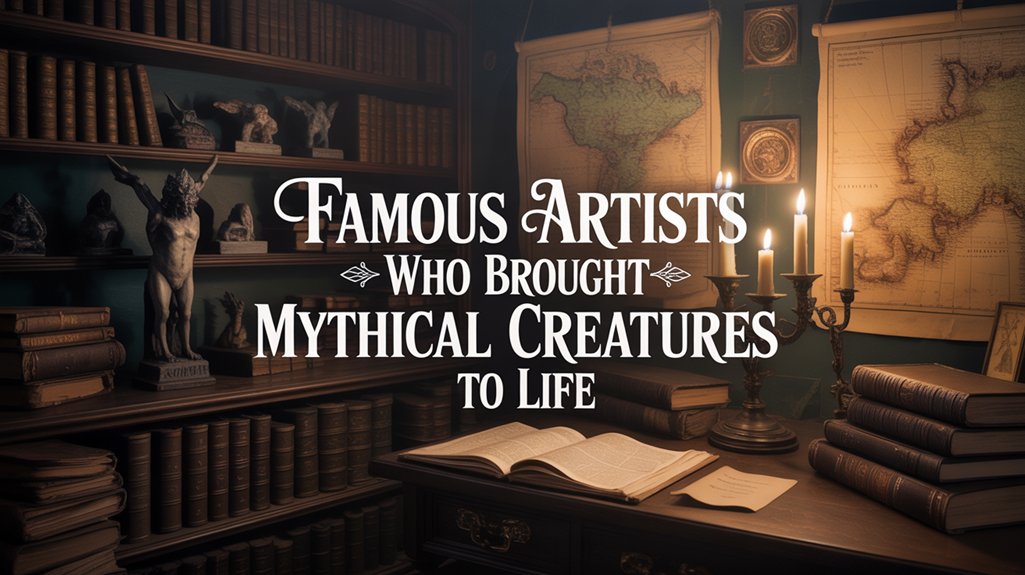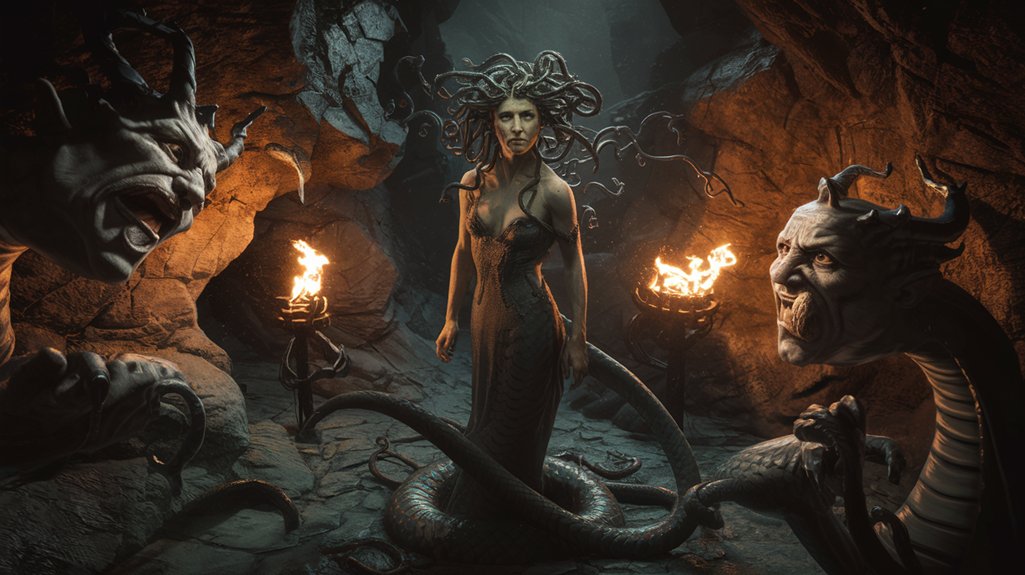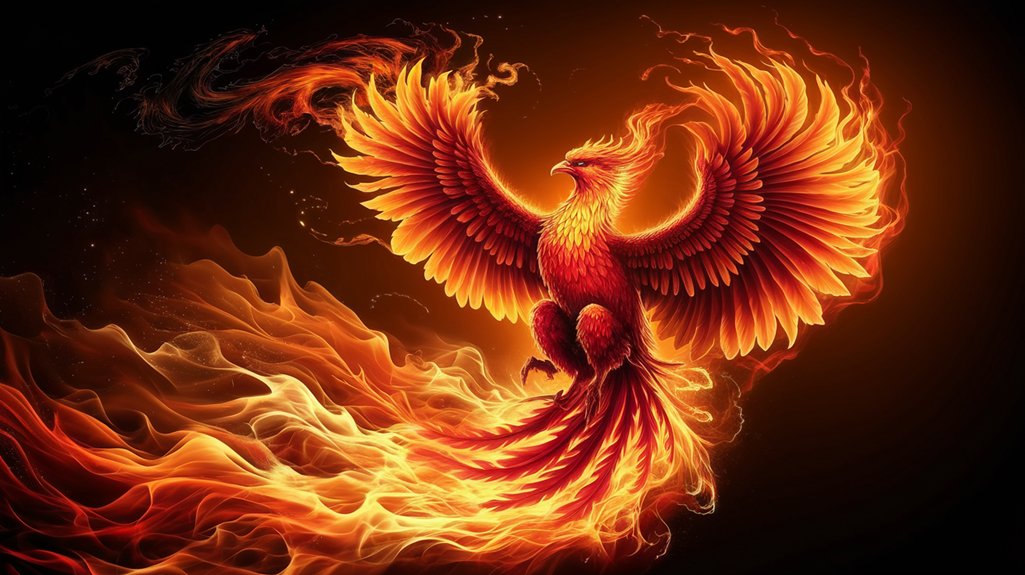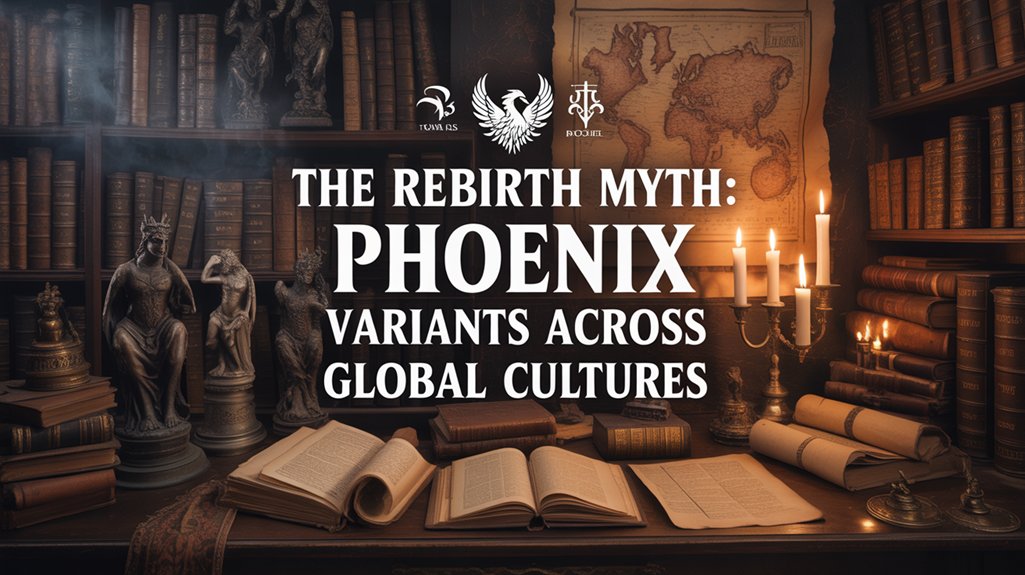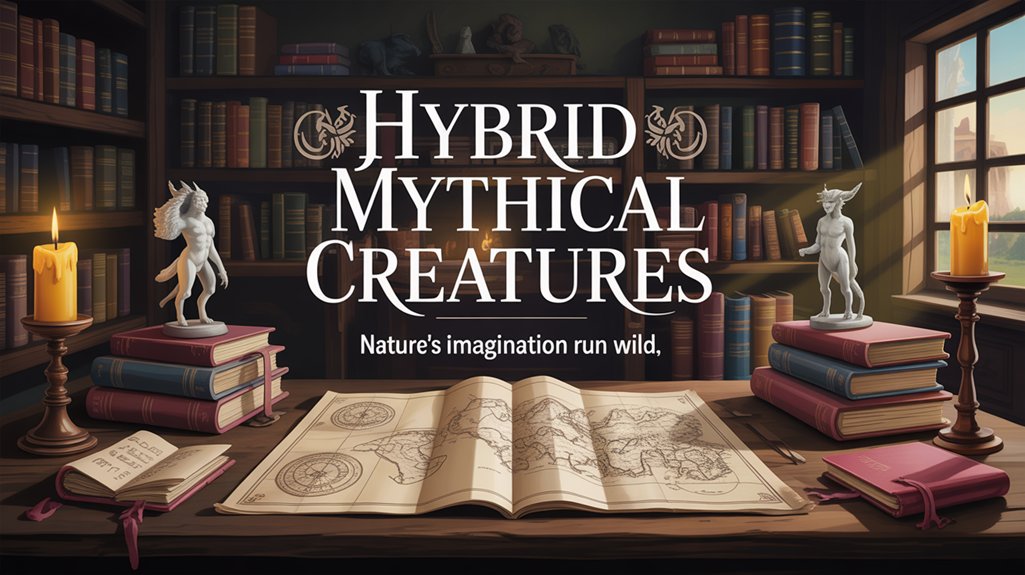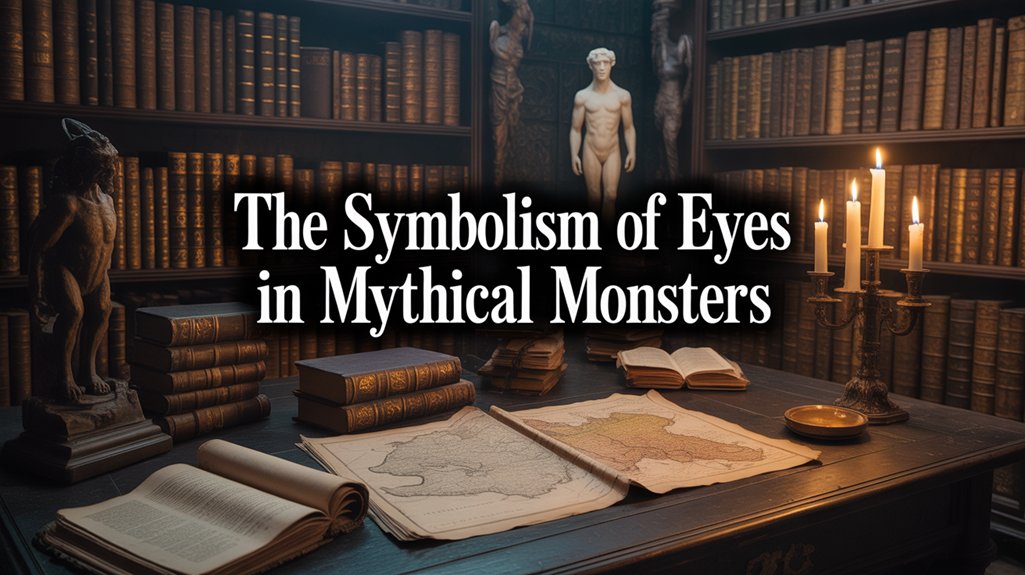
You’ll encounter visionaries across millennia who converted whispered legends into tangible forms: prehistoric shamans painting aurochs and chimeric sorcerers at Lascaux and Les Trois Frères, Renaissance masters like Botticelli channeling Hellenic ideals, Symbolist Gustave Moreau conjuring sphinxes from dreamscapes, Surrealist Salvador Dalí bending mythical anatomy, and Ray Harryhausen sculpting cinematic gods through stop-motion alchemy. Contemporary digital artists like Greg Rutkowski now resurrect dragons through neural networks and render engines, while Takashi Murakami commands millions for works echoing ancestral power—each generation preserving archetypal creatures as psychological cartography guiding humanity through its eternal labyrinths of shadow and transcendence.
Table of Contents
ToggleKey Takeaways
- Botticelli, Michelangelo, and Raphael depicted mythical creatures during the Renaissance, blending classical mythology with humanist ideals and moral instruction.
- Gustave Moreau and Odilon Redon explored psychological depths through sphinxes and chimeras during the Symbolist movement’s dreamlike interpretations.
- Salvador Dalí and Max Ernst transformed mythical beasts into surrealist dream imagery, liberating mythology from traditional academic constraints.
- Ray Harryhausen revolutionized creature design through stop-motion animation, influencing modern film directors like Peter Jackson and James Cameron.
- Contemporary digital artists like Kadir Nelson and Greg Rutkowski modernize ancient mythical forms using advanced rendering engines and neural networks.
Mythology Made Visible Through Art

When brush met parchment and chisel carved bronze in the ancient workshops of Europa, artists altered the ineffable essence of mythology into tangible form, rendering the chimeric and the eldritch visible to mortal eyes.
You’ll witness this alteration in the Wounded Chimera of Arezzo, an Etruscan bronze capturing Bellerophon’s legendary battle, where artistic representations transcended mere decoration to become vessels of cultural memory.
From the 15th through 18th centuries, masters like Lucas Cranach the Elder and Giulio Bonasone wielded engraving tools as instruments of mythical symbolism, their intricate linework breathing life into folklore’s hybrid creatures.
Medieval bestiaries merged zoological observation with imaginative storytelling, each illuminated page offering moral instruction through fantastic beasts.
Gothic gargoyles served dual purposes—protecting sacred spaces while embodying ancient beliefs about warding malevolent forces.
Even cartographers populated their maps with sea serpents and griffins, filling geographical voids with artistic imagination.
These creators understood what you’re discovering now: mythology demands visibility to endure.
##
Throughout centuries of artistic evolution, mythical creatures have served as vessels through which painters, printmakers, and digital creators channel humanity’s most eldritch visions into tangible form.
You’ll witness how Renaissance virtuosos like Cranach and Goltzius carved chimeric beings into copper plates with surgical precision, how Symbolists and Surrealists—Dalí, Ernst—transformed ancient beasts into psychological landscapes of the unconscious, and how today’s digital artists resurrect these primordial forms through luminous screens.
Each movement, from the devotional bestiaries of medieval scriptoria to contemporary CGI renderings, preserves the sacred lineage of creatures that exist in that liminal space between empirical nature and collective dream.
These artistic interpretations transform mythological creatures symbolizing humanity’s deepest fears into visual narratives that span from ancient cave paintings to modern digital canvases.
Renaissance Masters and Mythology
As the fifteenth century dawned across the Italian peninsula, a profound metamorphosis seized the artistic consciousness—masters of brush and chisel began summoning forth the chimeric forms and divine pantheons of classical antiquity with unprecedented fervor.
You’ll witness Renaissance humanism manifest through Botticelli’s “Birth of Venus,” where mythological symbolism transcends mere decoration. The goddess emerges from foam-touched waves, embodying philosophy made flesh.
Michelangelo carved David, channeling Hellenic ideals into marble sinew. Raphael’s Vatican frescoes position philosophy alongside deity—Athens’s wisdom flows through pigment and plaster.
These weren’t simple ornaments. Each creature, each god carried eldritch significance: moral instruction wrapped in beauty’s guise. The ancients spoke again through Florentine hands, whispering truths about humanity’s divine potential, about freedom found through knowledge’s pursuit. Through these visual narratives, artists preserved timeless fables that reflected the beliefs and values inherited from Greek and Roman civilizations.
Symbolist Movement’s Dark Visions
Where Renaissance masters had sought elevation through classical harmony, the Symbolists of fin-de-siècle Europe plunged their brushes into shadow’s depths—summoning forth mythical creatures not as emblems of human transcendence but as mirrors reflecting psychological abysses.
You’ll discover how Gustave Moreau’s sphinxes materialized from dreamscapes circa 1864, their enigmatic gazes piercing your certainties.
Odilon Redon altered traditional mythology into personal visions through symbolic imagery, his charcoal chimeras embodying unspoken terrors.
These artists rejected literal representation. They channeled the eldritch. Mermaids became desire incarnate, harpies manifested as inner torment—each creature pulsing with emotional resonance that transcended mere decoration.
This liberation from academic constraints birthed Surrealism’s eventual flowering, proving mythological beings could navigate consciousness’s unmarked territories, forever reshaping fantasy art’s trajectory through their haunting, autonomous presence.
Surrealists Reimagine Ancient Beasts
From the Symbolists’ shadowed domains emerged Surrealism—a movement that didn’t merely darken mythology but shattered its anatomical logic entirely.
You’ll witness Salvador Dalí’s elephants stretched into impossible proportions, their spindly legs defying gravity while channeling ancient strength through dream imagery. Max Ernst conjured chimeric entities in works like “The Oedipus Rex,” fusing classical narratives with unconscious symbolism.
These artists understood something profound: mythical beasts weren’t historical relics but psychological emanations.
Through surrealist symbolism, dragons and sphinxes became portals into the psyche’s eldritch depths. Ernst’s hybrid creatures, Dalí’s elongated forms—each alteration liberated mythology from academic constraint.
The subconscious domain they explored revealed mythical beings as eternal archetypes, unbound by rationality. Pure manifestation of internal truth.
Contemporary Digital Artists Today
Though Surrealism fractured mythology through analog dreamscapes, contemporary digital artists wield an unprecedented arsenal—render engines, procedural generation algorithms, neural networks trained on millennia of visual culture.
You’ll discover Kadir Nelson and Greg Rutkowski transmuting ancient chimeric forms through Photoshop’s infinite layers, Blender’s sculpting tools breathing dimensional life into eldritch beings born from Japanese yōkai, Celtic sidhe, Native American thunderbirds.
ArtStation becomes your portal, DeviantArt your grimoire, where digital techniques merge with ancestral vision. These artists forge artistic collaborations across continents, their hyper-realistic renderings served to gaming industries hungry for authentic mythological resonance.
Virtual reality now permits you to walk through their conjured domains, augmented reality overlaying ancient gods onto modern streets. The sacred persists, pixel-rendered yet profound.
Cave Paintings of Ancient Beasts

You stand before the limestone walls of Lascaux, seventeen millennia removed from the Paleolithic hunters who ground ochre and charcoal into primordial pigment, rendering the aurochs—those massive, now-extinct bull-like creatures—with such anatomical precision that their musculature still ripples across the stone.
These southwestern French caves preserve not mere decoration but ritual documentation, each massive beast positioned according to ceremonial logic that changed hunting grounds into sacred chambers where survival and the numinous merged.
The artists captured something eldritch in those horned forms, freezing the aurochs mid-charge with a liveliness that suggests these images served as thresholds between the physical act of the hunt and its spiritual consecration.
Lascaux Bull-like Creatures, 17,000 BCE
Deep within the limestone corridors of southwestern France’s Dordogne Valley, prehistoric hands conjured forth images that still pulse with eldritch significance after seventeen millennia.
You’ll discover aurochs—primordial bulls rendered in mineral pigments across 2,000 square meters of sacred stone. Over 600 creatures emerge from darkness, their ochre forms depicting sophisticated anatomical knowledge and kinetic energy.
These bull-like beings transcend mere documentation of hunting practices; they embody cultural symbolism intertwined with spiritual communion between human consciousness and the wild.
The prehistoric artistry demonstrates mastery of movement, capturing muscle and momentum with precision that rivals contemporary naturalism.
UNESCO recognizes this threshold space where Paleolithic peoples altered rock faces into portals, preserving their reverence for nature’s magnificent herbivores—horses, deer, and those magnificent aurochs whose presence still commands attention.
Southwestern France Cave Location
Three cathedral-like chambers perforate the Vézère Valley’s limestone escarpments, their Paleolithic galleries converting southwestern France’s Dordogne and Ardèche regions into humanity’s first sanctuaries of symbolic thought. You’ll discover through cave exploration that these subterranean temples—Lascaux, Chauvet, Font-de-Gaume—preserve 15,000 to 40,000 years of prehistoric artistry, their walls alive with ochre-stained megafauna.
| Site | Discovery | Age (Years) | Featured Beasts | Spiritual Resonance |
|---|---|---|---|---|
| Lascaux | 1940 | 17,000 | 600+ animals, bulls | Your liberation through movement |
| Chauvet | 1994 | 40,000 | Woolly rhinoceros, saber-tooths | Primal connection unfettered |
| Font-de-Gaume | 1901 | 14,000 | Bison, mammoths | Ancient wisdom unbound |
| Les Combarelles | 1901 | 13,000 | Horses, reindeer | Nomadic freedom eternal |
| Rouffignac | 1956 | 13,000 | Mammoth processions | Transcendent wildness preserved |
These eldritch sanctuaries whisper autonomy’s origins.
Paleolithic Hunting Ritual Documentation
When lamplight first pierced Lascaux’s Hall of Bulls in 1940, four teenage boys witnessed humanity’s primordial contract with the wild—a 17,000-year-old record wherein ochre-dusted aurochs, their muscular flanks rendered in charcoal strokes six meters long, thundered across calcite walls in perpetual motion.
You’re confronting sympathetic magic here, ritualistic practices where representation wielded power over flesh-and-blood quarry. Bison. Horses. Deer. Each creature bore Paleolithic symbolism linking survival to spiritual communion.
These weren’t mere sketches but incantations in pigment, ensuring successful hunts through visual invocation. Consider Les Trois Frères’ chimeric sorcerer—antlered, owl-eyed, part-human amalgam dancing eternally in stone.
This eldritch figure marks where early humans crossed thresholds between observation and imagination, documenting not just what roamed outside firelit caves, but what stirred within their awakening consciousness.
Global Beast Mythology Comparisons

How do civilizations separated by vast oceans and millennia construct remarkably parallel visions of the monstrous, the divine, and the chimeric? Beast symbolism reveals humanity’s shared psychological architecture, yet creature comparisons expose profound cultural divergences that honor each tradition’s sovereign wisdom.
| Region | Creature | Symbolic Essence |
|---|---|---|
| Greece | Minotaur | Ambition’s labyrinthine nature |
| China | Dragon | Celestial unity, prosperity |
| Europe | Dragon | Chaos, malevolent destruction |
| Ireland | Banshee | Mortality’s inexorable approach |
| Japan | Kitsune | Shapeshifting intelligence |
The Chinese dragon ascending through clouds embodies heaven touching earth—strength manifested. European dragons hoard gold in darkness, representing disorder’s seductive power. Africa’s Inkanyamba serpent commands tempests, while India’s Naga guards waters with cyclical wisdom. These eldritch beings aren’t mere fantasy—they’re psychological cartography, mapping each culture’s relationship with power, nature, alteration. You’re witnessing humanity’s shared yet distinctly expressed metaphysical vocabulary.
Protective Talismans and Spiritual Power
Before script or scripture, humanity carved its terror of darkness into protective forms—stone guardians that altered vulnerability into vigilant defense.
You’ll find mythical symbolism embedded in every civilization’s architectural DNA, where artistic protection transcended mere decoration to become spiritual armor. The Lamassu of ancient Mesopotamia, those chimeric sentinels combining bovine strength with avian transcendence, stood watch over Assyrian gates circa 700 BCE, their eldritch presence deterring malevolent forces through sheer monumental authority.
Consider how artists channeled protective power through three primary forms:
- Gargoyles—Gothic watchers that expelled both rainwater and evil
- Griffins—heraldic guardians merging leonine ferocity with eagle vigilance
- Dragons—Chinese protectors coiling around temples, altering chaos into fortune
Egyptian scarab amulets, Chinese fu dogs, European grotesques—each carved manifestation served as tangible resistance against unseen threats.
These weren’t superstitious trinkets but deliberate artistic interventions, changing stone and metal into shields against the unknowable void.
Dragon Guardians in Chinese Art
You’ll find the dragon guardian emerging from China’s imperial courts as an eldritch embodiment of sovereign might, its serpentine form coiling through millennia of dynastic rule with scales that shimmer like jade beneath ceremonial lamplight.
These celestial beings—neither wholly terrestrial nor fully divine—manifest through brushwork techniques perfected during the Tang and Song dynasties, where masters wielded ink and mineral pigments to capture the chimeric essence of creatures that commanded rain, rivers, and the very mandate of heaven itself.
The five-clawed *long* reserved exclusively for emperors evolves from mythological guardian into political symbol, its presence on silk scrolls and palace walls declaring authority that transcends mortal governance.
Imperial Dragons and Power
Across the gilded halls of the Forbidden City and throughout the dynasties that shaped Imperial China from 221 BCE onward, the five-clawed dragon—known as the *longwang* or Dragon King—manifested not merely as decorative motif but as the living embodiment of celestial authority itself.
You’ll find this dragon symbolism woven into every thread of imperial power, its serpentine form commanding water, weather, and fortune itself. Imperial authority demanded exclusivity: only the emperor could don robes bearing these eldritch beings.
Five claws distinguished divine right from mortal pretension. Palace thrones bore their chimeric presence, each scale and whisker rendered with meticulous precision.
These weren’t mere artistic flourishes—they were cosmological declarations, inscribed in jade, carved in stone, painted on silk to invoke protection and prosperity.
Celestial Dragon Symbolism
When celestial dragons ascend through the painted scrolls and carved temple reliefs of dynastic China, they traverse domains far beyond imperial prerogative—these beings existed as *tianlong*, heavenly serpents who dwelled in the uppermost celestial palaces, guarding the mansions of the gods themselves.
Their dragon representation manifests through sinuous forms wreathed in cumulus clouds, clutching luminous pearls that symbolize enlightenment and cosmic potency. Artists rendered these chimeric guardians with antlered crowns and flowing whiskers, their scales catching ethereal light between heaven and earth.
The cultural significance of *tianlong* transcends mere decoration; they’re intermediaries who transmute celestial qi into terrestrial blessing, bringing spring rains that nourish rice paddies below.
You’ll find them coiling through Song Dynasty ceramics and Ming murals—eldritch protectors maintaining cosmic harmony, their presence promising liberation from spiritual drought.
Traditional Painting Techniques
Four fundamental techniques governed how master painters conjured dragon guardians onto silk and paper—methods refined across millennia that altered mineral pigments and animal-hair brushes into vessels for divine manifestation.
You’ll discover traditional brushwork demanding absolute precision: each scale rendered through controlled pressure, each claw articulated with decisive strokes that captured eldritch power.
The gongbi method emphasized meticulous detail. Xieyi celebrated spontaneous expression.
Artists deployed vibrant colors—cinnabar reds, malachite greens, lapis blues—ground from sacred minerals to evoke celestial radiance.
Ink gradations created chimeric forms emerging from swirling clouds, their bodies shifting between solid matter and vapor.
Water guided brushes across rice paper, allowing pigments to bleed and merge, manifesting dragons as liminal beings inhabiting thresholds between earthly kingdoms and heavenly domains.
Film and Gaming Creature Design
Through the alchemy of celluloid and clay, Ray Harryhausen converted the chimeric visions of ancient myth into tangible cinema—his hands sculpting armatures that would breathe movement into creatures that had existed only in Mediterranean oral traditions and illuminated manuscripts.
His Dynamation process married stop-motion with live-action through rear-projection, engineering creature evolution from static folklore into kinetic reality. Animation techniques pioneered in “Jason and the Argonauts” reached their apex in the skeleton army sequence—seven ambulatory osseous warriors engaged in choreographed combat, frame by meticulous frame.
His influence reverberates through contemporary creators:
- Peter Jackson’s Middle-earth bestiary
- James Cameron’s xenomorphic designs
- Steven Spielberg’s prehistoric resurrections
You witness this legacy persisting in gaming’s digital mythscapes, where Harryhausen’s foundational principles—anatomical authenticity, narrative integration, eldritch wonder—inform every rendered gryphon and chimera.
The old magician’s fingerprints remain visible on screens both silver and pixelated.
Jung’s Archetypal Creature Symbolism
Beyond the mechanical domains of animation and film technique lies the psychological architecture that explains why these creatures—dragons, sirens, chimeras—persist with such tenacity in human consciousness.
Carl Jung revealed this mystery through his concept of the collective unconscious, where mythical beings transcend mere fantasy to become vessels of archetypal significance. You’ll discover dragons embodying your shadow-self, those eldritch terrors dwelling in psychic depths, demanding confrontation with repressed fears.
The anima manifests through sirens and goddesses, calling you toward integration of feminine wisdom; the animus rises through chimeric warriors, masculine power crystallized in form.
These aren’t decorative symbols—they’re psychological cartography. When artists resurrect these beings, they’re excavating universal human experience, mapping territories where conscious thought surrenders to primordial knowing. Each rendering becomes ritual, each creature a guide through your inner labyrinth.
Mythical creatures aren’t decorations—they’re maps of the psyche, guiding us through territories where consciousness dissolves into ancient, primordial truth.
Jung recognized what ancient cultures knew: mythical creatures bridge worlds, making visible the invisible architecture of human evolution.
Contemporary Art Market Value
Where psychology dissolves into commerce, mythical creatures have transmuted from archetypal vessels into market phenomena—commanding valuations that mirror their ancient talismanic power.
You’re witnessing unprecedented market trends: Takashi Murakami’s chimeric visions fetch millions, while Yoshitomo Nara’s eldritch beings breach ten-million-dollar thresholds. The digital domain amplifies this alteration—Beeple’s NFT mythologies achieved $69 million, obliterating traditional boundaries between the sacred and the speculative.
Art investment now recognizes what ancient cultures intuited: mythological imagery possesses inherent value beyond aesthetics. Collectors pursue these works with acquisitive fervor, understanding that contemporary artists channeling primordial forms tap into something collectively resonant, eternally marketable.
Galleries report surging demand for emerging creators who weave mythological threads through their practice, their pieces appreciating rapidly as pop culture merges with fine art traditions.
The phenomenon transcends mere speculation. These aren’t simply paintings or tokens—they’re contemporary talismans, carrying forward humanity’s oldest stories into markets that finally acknowledge their altering worth.
Legacy Lives Through Imagination
Market valuations measure only temporal worth—the true legacy of mythical creatures persists in domains commerce can’t quantify. You witness how imaginative storytelling transcends centuries, from Sterrett’s delicate faerie courts to Rackham’s eldritch forests, each artistic interpretation becoming a gateway for subsequent generations.
The chimeric beings captured by Cranach the Elder and Goltzius during the Renaissance established visual vocabularies that contemporary digital artists still reference, adapt, alter. Medieval bestiaries blended empirical observation with fantastical invention, creating taxonomies where griffins existed alongside lions, both equally real within cultural consciousness.
Your engagement with these works perpetuates their power. When Guerber and Hamilton documented mythological traditions, they preserved not mere illustrations but living heritage—cosmological frameworks entire civilizations once inhabited. The phoenix rises perpetually. The dragon guards eternal wisdom.
These archetypal forms survive because artists refused containment, choosing instead to explore liminal spaces between known and unknown, offering you liberation through wonder itself.
Frequently Asked Questions
Which Specific Artists Are Most Famous for Depicting Mythical Creatures?
You’ll find Hieronymus Bosch (1450-1516) masterfully rendering chimeric beings in “The Garden of Earthly Delights,” their eldritch forms dripping with mythical symbolism.
Gustave Moreau captured Symbolist visions of sphinxes and griffins, their cultural influence reshaping nineteenth-century European consciousness.
William Blake altered biblical leviathans into visionary prophecy.
Ancient masters matter too—Greek vase painters immortalized Medusa’s serpentine horror, while Japanese artists breathed life into dragon-kami.
Each creator channeled primordial archetypes, offering you liberation through imagination’s boundless territories.
What Materials and Techniques Did Artists Use to Create These Creatures?
You’ll discover artists wielded bronze-casting and marble-carving as portals to the numinous.
Renaissance masters employed tempera and oil glazes, their sculptural techniques breathing dimensionality into chimeric forms—Cellini’s Perseus emerged through lost-wax casting, bronze altered into eldritch triumph.
Color symbolism wasn’t arbitrary: vermillion signified divine power, ultramarine invoked celestial spheres.
Medieval illuminators ground lapis lazuli, binding pigment with egg yolk to manifest dragons and griffins.
These weren’t mere methods—they were alchemical practices, converting earthly materials into transcendent visions that still captivate your unbound imagination.
How Much Do Original Mythical Creature Artworks Typically Sell For?
You’ll find original artwork pricing in the mythical art market spans vast territories—from $5,000 for emerging artists’ chimeric visions to millions for established masters.
Auction houses record eldritch pieces commanding $50,000 to $500,000, though truly ancient renderings transcend monetary bounds.
Contemporary phoenix paintings, dragon scrolls, and serpent tapestries fluctuate wildly; provenance, artist reputation, and cultural significance determine value.
The market remains unregulated, gloriously untamed—your investment mirrors the creatures themselves, unpredictable yet eternally enthralling.
Where Can I View the Most Famous Mythical Creature Artworks Today?
Like portals into primordial domains, you’ll discover these chimeric masterpieces across the world’s premier institutions.
The Louvre houses Delacroix’s eldritch visions, while London’s Tate Britain preserves Blake’s apocalyptic beasts.
You’re free to explore contemporary fantasy art through mythical creature exhibitions at New York’s Museum of Modern Art and Tokyo’s Mori Art Museum.
The Prado in Madrid, steeped in Bosch’s haunting imagery, offers unparalleled access to medieval European manifestations of the fantastic, the monstrous, the divine.
Did These Artists Believe in the Creatures They Painted?
You’ll find artist beliefs varied profoundly across centuries and cultures.
Renaissance masters like Bosch employed creature symbolism as theological allegory, painting chimeric forms they understood metaphorically rather than literally.
Yet medieval illuminators, Persian miniaturists, and Japanese ukiyo-e painters often depicted dragons, djinn, and yokai within living cosmological frameworks—eldritch beings their societies genuinely honored.
The distinction blurs beautifully: these creators channeled archetypal truths transcending simple belief, rendering numinous forces that shaped collective consciousness regardless of personal conviction.
Conclusion
You’ve witnessed how artists convert primordial archetypes into tangible form, their brushstrokes bridging the chasm between myth and materiality. These chimeric visions—rendered through pigment, bronze, and pixel—aren’t mere decorative flourishes but cultural vessels carrying ancestral wisdom. As you encounter dragons coiling through Song Dynasty scrolls or eldritch beings haunting contemporary galleries, you’re participating in humanity’s oldest ritual: giving shape to the numinous. The threshold between worlds remains permeable through art’s converting power.

